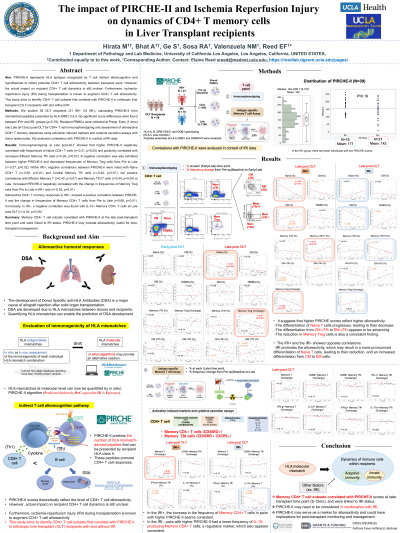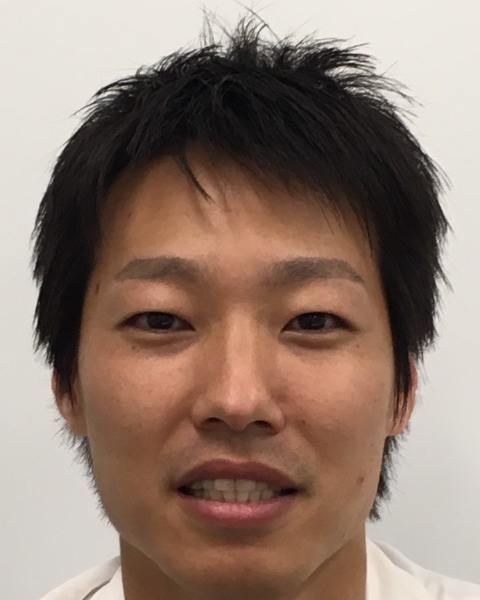Back

(P501) The impact of PIRCHE-II and ischemia reperfusion injury on dynamics of CD4+ T memory cells in liver transplant recipients
Location: Platinum Ballroom

Poster Presenter(s)
Aim: PIRCHE-II represents HLA epitopes recognized by T cell indirect allorecognition and hypothesized to reflect potential CD4+ T cell alloreactivity between transplant pairs. However, the actual impact on recipient CD4+ T cell dynamics is still unclear. Furthermore, ischemia-reperfusion injury (IRI) during transplantation is known to augment CD4+ T cell alloreactivity. This study aims to identify CD4+ T cell subsets that correlate with PIRCHE-II in orthotopic liver transplant (OLT) recipients with and without IRI.
Method: We studied 39 OLT recipients (21 IRI+ /18 IRI-), calculating PIRCHE-II from mismatched peptides presented by HLA-DRB1,3,4,5. No significant score differences were found between IRI+ and IRI- groups (p=0.19). Recipient PBMCs were collected at Preop, Early (1-4mo), and Late (6-12mo) post-OLT for CD4+ T cell immunophenotyping and assessment of alloreactive CD4+ T memory responses using activation induced markers and cytokine secretion assays with donor splenocytes. We analyzed correlations with PIRCHE-II in context of IRI data.
Results: Immunophenotyping at Late post-OLT showed that higher PIRCHE-II negatively correlated with frequencies of Naive CD4+ T cells (r=-0.31, p=0.05) (Fig. A) and positively correlated with increased Effector Memory Tfh cells (r=0.29, p=0.07) (Fig. B). A negative correlation was also exhibited between higher PIRCHE-II and decreased frequencies of Memory Treg cells from Pre to Late (r=-0.37, p=0.02). Within IRI+, negative correlations between PIRCHE-II were noted with Naive CD4+ T (r=-0.60, p<0.01) and Central Memory Tfh cells (r=-0.40, p=0.07), but positive correlations with Effector Memory T (r=0.40, p=0.07) and Memory Tfh17 cells (r=0.44, p=0.04) at Late. Increased PIRCHE-II negatively correlated with the change in frequencies of Memory Treg cells from Pre to Late in IRI+ only (r=-0.53, p=0.01) (Fig. C, D).
Alloreactive CD4+ T memory responses in IRI+, showed a positive correlation between PIRCHE-II and the change in frequencies of Memory CD4+ T cells from Pre to Late (r=0.68, p<0.01) (Fig. E). Conversely, in IRI-, a negative correlation was found with IL-10+ Memory CD4+ T cells at Late post-OLT (r=-0.44, p=0.09) (Fig. F).
Conclusion: Memory CD4+ T cell subsets correlated with PIRCHE-II at the late post-transplant time point and were linked to IRI status. PIRCHE-II may indicate alloreactivity, useful for post-transplant management.
Method: We studied 39 OLT recipients (21 IRI+ /18 IRI-), calculating PIRCHE-II from mismatched peptides presented by HLA-DRB1,3,4,5. No significant score differences were found between IRI+ and IRI- groups (p=0.19). Recipient PBMCs were collected at Preop, Early (1-4mo), and Late (6-12mo) post-OLT for CD4+ T cell immunophenotyping and assessment of alloreactive CD4+ T memory responses using activation induced markers and cytokine secretion assays with donor splenocytes. We analyzed correlations with PIRCHE-II in context of IRI data.
Results: Immunophenotyping at Late post-OLT showed that higher PIRCHE-II negatively correlated with frequencies of Naive CD4+ T cells (r=-0.31, p=0.05) (Fig. A) and positively correlated with increased Effector Memory Tfh cells (r=0.29, p=0.07) (Fig. B). A negative correlation was also exhibited between higher PIRCHE-II and decreased frequencies of Memory Treg cells from Pre to Late (r=-0.37, p=0.02). Within IRI+, negative correlations between PIRCHE-II were noted with Naive CD4+ T (r=-0.60, p<0.01) and Central Memory Tfh cells (r=-0.40, p=0.07), but positive correlations with Effector Memory T (r=0.40, p=0.07) and Memory Tfh17 cells (r=0.44, p=0.04) at Late. Increased PIRCHE-II negatively correlated with the change in frequencies of Memory Treg cells from Pre to Late in IRI+ only (r=-0.53, p=0.01) (Fig. C, D).
Alloreactive CD4+ T memory responses in IRI+, showed a positive correlation between PIRCHE-II and the change in frequencies of Memory CD4+ T cells from Pre to Late (r=0.68, p<0.01) (Fig. E). Conversely, in IRI-, a negative correlation was found with IL-10+ Memory CD4+ T cells at Late post-OLT (r=-0.44, p=0.09) (Fig. F).
Conclusion: Memory CD4+ T cell subsets correlated with PIRCHE-II at the late post-transplant time point and were linked to IRI status. PIRCHE-II may indicate alloreactivity, useful for post-transplant management.

